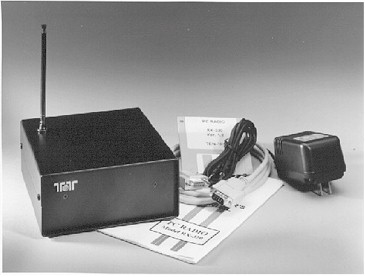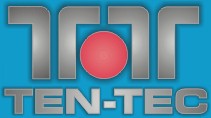| RX-320
PC RADIO SHORTWAVE RECEIVER |

Ten-Tec's RX-320 PC Radio -
only $295.00
factory direct
The introduction of the
Ten-Tec RX-320
HF DSP "PC Radio" in 1998
marked the first time that the power of a personal
computer could be harnessed and dedicated to superb
quality shortwave listening. Instead of traditional
discrete electronic components inside the radio, the RX-320
uses digital signal processors inside the 'black box'
and uses your personal computer for the horsepower to
run the radio. Replacing components with software
code results in less cost to manufacture the radio,
and vastly better receiver performance than could be
afforded at the same price point with a traditional
component-based shortwave radio. Reviews of the radio
(some referenced below) have been outstanding on
their commentary for value vs. performance for RX-320.
If the referenced reviews aren't proof enough, we
encourage you to pick an Internet search engine like
Google and search under 'Ten-Tec RX-320',
'RX-320
reviews', or similar to see even more feedback.
Shortwave listening is no
longer the exclusive domain of dedicated enthusiasts.
A wealth of fascinating and
enjoyable worldwide listening is a mouse click away
on your PC. Starting with local AM broadcasts (same
as the AM dial in your car), this band is more active
than it has been in decades offering in-depth news,
sports and talk radio. After dark, this same band
takes you half way across the country!
This is only the beginning.
Most
countries broadcast programs around the globe on
nearly a dozen international shortwave broadcast
bands. In English, and nearly every other language,
you can hear both world and local news from their
viewpoint. Programs also include cultural and
political topics and even music you may never have
heard before. These bands also provide a wealth of
information during times of international crisis. Ham
radio operators are spread out across nine bands,
sometimes talking across town to friends, and often
to other hams 1000's of miles away. To round out the
listening choices you will hear military operations,
commercial airlines and even CB radio.
This product
was designed for two types of people: the PC user who
has never listened to shortwave and the experienced
listener who appreciates the powerful marriage of PC
and the shortwave hobby. The manual includes a
phenomenal beginner's guide written by respected
author and columnist, Joe Carr, K4IPV.
The PC Radio is a
standalone, black box that only requires access to a
serial port and one megabyte of free hard drive space
for the software. It runs on either Windows � 3.1 or
Windows ® 95/98. No need to go inside your PC or tie
up an accessory slot. PC Radio includes a built-in
telescoping whip antenna or listening range can be
significantly extended with a simple external wire
antenna.
As with most
Windows ® programs, you can launch the PC Radio, tune in an
interesting station and then put it in the background
while you do other PC tasks. In fact, you could surf
the Web and listen to shortwave at the same time!
Like
conventional shortwave receivers, the PC Radio tunes from
100 kHz to 30 MHz. But the similarity stops there.
This is a true Digital Signal Processing or
"DSP" based receiver. This cutting edge,
software based technology dramatically reduces the
number of individual electronic components inside.
This makes it possible to provide features only
dreamed of in previous receivers in this price class.
Even the most experienced shortwave enthusiasts will
marvel at the basic performance.
Included with
the RX-320 are a
detachable, collapsible whip antenna, the RX-320 software on
a 3.5 inch floppy disc, serial port cable for
connection to your PC, wall transformer for
connection to 110 VAC mains, and an operation manual
that includes the shortwave guide written by Joe
Carr.
MODEL RX-320 SPECIFICATIONS
MODES: AM, LSB, USB, CW
FREQUENCY RANGE: 100 kHz - 30 MHz
FREQUENCY
ACCURACY: +/- 100 Hz at 25
degrees C.
MEMORIES: Limited only by
available RAM in PC, virtually any PC will store 1000's
of stations.
SENSITIVITY:
MODE
|
B/W
|
Sensitivity
|
AM (80% mod @ 1
kHz)
|
6 kHz
|
.64 uV for 12 dB S+N/N
|
CW/SSB
|
2.5 kHz
|
.3 uV for 10 dB S+N/N
|
SELECTIVITY: 34 IF-DSP
bandwidth filters built-in. 300 Hz, 330 Hz, 375-750 Hz in
75 Hz steps, 750-3000 Hz in 150 Hz steps, 3000-6000 Hz in
300 Hz steps, 8 kHz.
THIRD ORDER
INTERCEPT: + 10 dBm
DYNAMIC RANGE: 90 dB @2.4 kHz
bandwidth at 50 kHz spacing
I-F FREQUENCIES: 1st I-F 45 MHz,
2nd I-F 455 kHz, 3rd I-F 12 kHz
I-F REJECTION: > 60 dB
IMAGE REJECTION: > 60 JB
ANTENNA: 50 ohm
unbalanced for external antenna. High impedance at
telescoping whip connection, automatically switched out
of line when external antenna connected.
PC INTERFACE: Industry
standard serial interface on DB9 connector
CONNECTIONS: + DC input, DB9
for serial port, external antenna, line output to sound
card, external speaker.
POWER REQUIRED: < 500 mA at
13.5 - 15 VDC, wall transformer supplied
AUDIO: 1 watt at 4
ohms. > 1 v p-p output into 600 ohms (typical to drive
a sound card).
CONSTRUCTION: 2 epoxy glass PC
boards, aluminum chassis, steel top and bottom
SIZE: HWD 3 "x
6.25 "x 6.5"
WEIGHT: 2.5 lbs (1.14
kg)
All
specifications are typical, degraded performance below
500 kHz
For
independent reviews of the RX-320, click
the links below:
December 1998,
Journal of the North American Shortwave Association
North American Shortwave Association Review
See the RX-320 review in the
February 1999 issue of Popular Communications magazine.
Paper reprints
are available from the Ten-Tec sales department courtesy
CQ Communications, Inc.
See the RX-320 review in QST
magazine, March 1999
Paper reprints
are available from the Ten-Tec sales department courtesy
of American Radio Relay League, Inc. An Adobe Acrobat
(tm) .PDF file of this article is also available via the
ARRL web site at www.arrl.org for ARRL members
only.
The SWBC DX and
Listening web page review
www.r390a.com/html/ten_tec_rx-320.html
Yahoo(tm) Groups located at http://groups.yahoo.com/
has two active email discussion groups regarding the RX-320
receiver, comprised of thousands of email messages dating
back to March 1999.
| 


